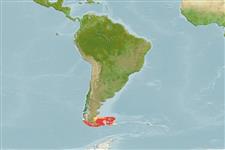Actinoptérygiens (poissons à nageoires rayonnées) >
Perciformes (Perch-likes) >
Channichthyidae (Crocodile icefishes)
Etymology: Champsocephalus: Greek, champso = crocodile, voracious predator + Greek, kephale = head (Ref. 45335).
Environnement / Climat / Gamme
Écologie
; marin démersal; profondeur 50 - 250 m (Ref. 27363). Temperate, preferred ?; 50°S - 56°S, 76°W - 56°W
Southern Ocean: Patagonian-Falkland region, Straits of Magellan and rarely at South Georgia.
Taille / Poids / Âge
Maturity: Lm ? range ? - ? cm
Max length : 35.0 cm SL mâle / non sexé; (Ref. 5200)
Épines dorsales (Total): 9; Rayons mous dorsaux (Total): 32; Épines anales 0; Rayons mous anaux: 31; Vertèbres: 57 - 60. Posterior margin of caudal fin emarginate. No scales except on lateral line. Body brown, irregularly mottled (Ref. 27363).
Feed mostly on fishes and krill.
Life cycle and mating behavior
Maturité | Reproduction | Frai | Œufs | Fécondité | Larves
Hureau, J.-C., 1985. Channichthyidae. p. 261-277. In W. Fischer and J.C. Hureau (eds.) FAO species identification sheets for fishery purposes. Southern Ocean (Fishing areas 48, 58 and 88). Rome. Vol. 2. (Ref. 2805)
Statut dans la liste rouge de l'IUCN (Ref. 115185)
CITES (Ref. 94142)
Not Evaluated
Menace pour l'homme
Harmless
Utilisations par l'homme
Pêcheries: commercial
Plus d'informations
Noms communsSynonymesMétabolismePrédateursÉcotoxicologieReproductionMaturitéFraiFéconditéŒufsDéveloppement de l'œuf
RéférencesAquacultureProfil d'aquacultureSouchesGénétiqueFréquences alléliquesHéritabilitéPathologiesTraitementMass conversion
Outils
Articles particuliers
Télécharger en XML
Sources Internet
Estimates of some properties based on models
Phylogenetic diversity index (Ref.
82805): PD
50 = 0.7500 [Uniqueness, from 0.5 = low to 2.0 = high].
Bayesian length-weight: a=0.00166 (0.00071 - 0.00386), b=3.43 (3.23 - 3.63), in cm Total Length, based on LWR estimates for this (Sub)family-body shape (Ref.
93245).
Niveau trophique (Ref.
69278): 3.9 ±0.65 se; Based on food items.
Résilience (Ref.
69278): Milieu, temps minimum de doublement de population : 1,4 à 4,4 années (Preliminary K or Fecundity.).
Vulnérabilité (Ref.
59153): Moderate vulnerability (40 of 100) .
